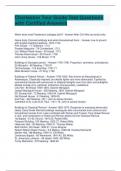Summary
Summary AQA A-Level 1C Tudors: Elizabeth I Revision Notes (A* achieved)
Detailed revision notes for Elizabeth I, part of the AQA A-Level 1C The Tudors: England, specification. Notes are easy to understand and full of relevant evidence to improve your essays. Areas covered include the Settlement, religious changes, society, economics, foreign relations and the War with ...
[Show more]













